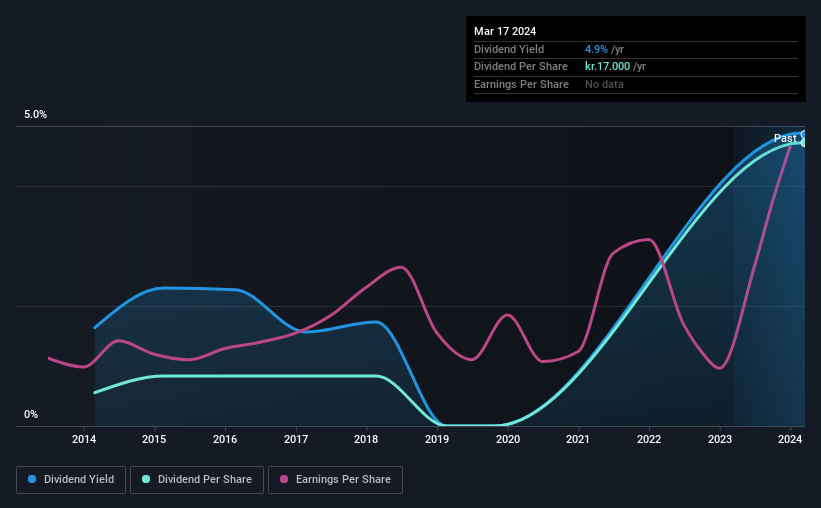Stock Analysis
Nordfyns Bank A/S (CPH:NRDF) Looks Interesting, And It's About To Pay A Dividend

Nordfyns Bank A/S (CPH:NRDF) stock is about to trade ex-dividend in three days. The ex-dividend date is usually set to be one business day before the record date which is the cut-off date on which you must be present on the company's books as a shareholder in order to receive the dividend. The ex-dividend date is important as the process of settlement involves two full business days. So if you miss that date, you would not show up on the company's books on the record date. Therefore, if you purchase Nordfyns Bank's shares on or after the 21st of March, you won't be eligible to receive the dividend, when it is paid on the 25th of March.
The company's next dividend payment will be kr.17.00 per share, on the back of last year when the company paid a total of kr.17.00 to shareholders. Based on the last year's worth of payments, Nordfyns Bank stock has a trailing yield of around 4.9% on the current share price of kr.350.00. We love seeing companies pay a dividend, but it's also important to be sure that laying the golden eggs isn't going to kill our golden goose! As a result, readers should always check whether Nordfyns Bank has been able to grow its dividends, or if the dividend might be cut.
View our latest analysis for Nordfyns Bank
Dividends are typically paid from company earnings. If a company pays more in dividends than it earned in profit, then the dividend could be unsustainable. Nordfyns Bank paid out a comfortable 26% of its profit last year.
Companies that pay out less in dividends than they earn in profits generally have more sustainable dividends. The lower the payout ratio, the more wiggle room the business has before it could be forced to cut the dividend.
Click here to see how much of its profit Nordfyns Bank paid out over the last 12 months.

Have Earnings And Dividends Been Growing?
Businesses with strong growth prospects usually make the best dividend payers, because it's easier to grow dividends when earnings per share are improving. If earnings fall far enough, the company could be forced to cut its dividend. It's encouraging to see Nordfyns Bank has grown its earnings rapidly, up 25% a year for the past five years.
Another key way to measure a company's dividend prospects is by measuring its historical rate of dividend growth. In the last 10 years, Nordfyns Bank has lifted its dividend by approximately 24% a year on average. Both per-share earnings and dividends have both been growing rapidly in recent times, which is great to see.
To Sum It Up
Is Nordfyns Bank worth buying for its dividend? When companies are growing rapidly and retaining a majority of the profits within the business, it's usually a sign that reinvesting earnings creates more value than paying dividends to shareholders. This strategy can add significant value to shareholders over the long term - as long as it's done without issuing too many new shares. Overall, Nordfyns Bank looks like a promising dividend stock in this analysis, and we think it would be worth investigating further.
In light of that, while Nordfyns Bank has an appealing dividend, it's worth knowing the risks involved with this stock. Our analysis shows 2 warning signs for Nordfyns Bank and you should be aware of these before buying any shares.
Generally, we wouldn't recommend just buying the first dividend stock you see. Here's a curated list of interesting stocks that are strong dividend payers.
Valuation is complex, but we're helping make it simple.
Find out whether Nordfyns Bank is potentially over or undervalued by checking out our comprehensive analysis, which includes fair value estimates, risks and warnings, dividends, insider transactions and financial health.
View the Free AnalysisHave feedback on this article? Concerned about the content? Get in touch with us directly. Alternatively, email editorial-team (at) simplywallst.com.
This article by Simply Wall St is general in nature. We provide commentary based on historical data and analyst forecasts only using an unbiased methodology and our articles are not intended to be financial advice. It does not constitute a recommendation to buy or sell any stock, and does not take account of your objectives, or your financial situation. We aim to bring you long-term focused analysis driven by fundamental data. Note that our analysis may not factor in the latest price-sensitive company announcements or qualitative material. Simply Wall St has no position in any stocks mentioned.
About CPSE:NRDF
Nordfyns Bank
Nordfyns Bank A/S provides banking and related financial products to individuals, and small and medium-sized businesses in Denmark.
Solid track record and good value.

